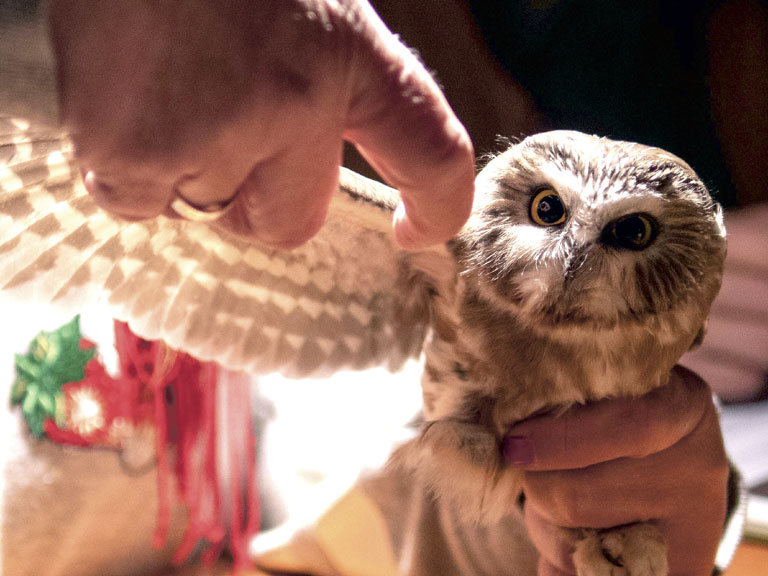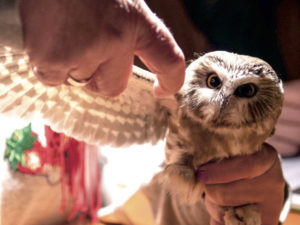County News
Tiny predator

Diminutive owl hunts on silent wings
As dusk deepens into night, a rather odd sound is heard at the Prince Edward Point Bird Observatory (PEPtBO) on the eastern tip of the County. Sounding a bit like “woop, woop, woop,” it is the recorded call of a saw-whet owl, the bird earning its name when early settlers thought the sound was reminiscent of a whetstone being used to sharpen a felling saw. These tiny owls weigh in at about 90 grams, or three ounces, with the females being the larger of the species. They are ferocious hunters of the night. Pity the poor deer mouse that rustles through the fallen leaves on a moonless night. Saw-whets have an acute sense of hearing and exceptional low-light vision. They swoop down from above on silent wings to snatch their prey in razor-sharp talons, with the result that the unfortunate rodent ends up as a tasty nighttime snack.

A female saw-whet owl is examined at the Prince Edward Point Bird Observatory.
Saw-whet owls are quite numerous and inhabit the boreal forests across the breadth of Canada, but little was known about their migratory habits. In the mid-1990s, a banding program was started to find out more about these owls. “It’s a long-term study across the continent,” said Matt Iles, bander-in-charge at PEPtBO. “People knew these owls migrated, but didn’t know where they were going, so the research started to find out more about their migratory pattern.” The breeding area for saw-whets is somewhat to the north of the County, and they pass through here on their way to their wintering grounds in midwest or southern US. The station at PEPtBO is one of 15 across Canada and is by far the busiest, with over 500 saw-whets being banded in a typical season. So far, over 12,000 of these owls have been banded at this site. The recorded call of the owl attracts these inquisitive birds and some are captured in nets. Volunteers at the observatory help to check on the health, age and sex of the captured owls. A numbered band is placed on the owl’s leg before it is released. All the information is recorded and contributes to a continent-wide database. The migration patterns are revealed when a previously banded owl is captured at one of the stations and its number is traced through the database. It appears that these owls do not follow fixed routes, but instead have a general north to south and back again pattern.
While these owls have a relatively large population, monitoring their numbers could provide an indication of the state of their habitat, which at present seems stable, unlike the habitat of species such as the shorteared owl whose habitat is now considered vulnerable. Saw-whets are primarily nocturnal birds, and they spend their days roosting among the tree branches. “These birds don’t sleep in the sense that we know,” said Iles. “They mostly rest during the day and keep their heart rate at a minimum. They remain alert and are keeping a low profile, particularly ones that are overwintering not too far south from here where there’s not much foliage on the trees, because there could be predators during the day such as other owls or hawks.”
So far, the number of saw-whet owls banded at PEPtBO this season has been less than normal, and the same was true of the songbird banding this fall. Weather conditions may have played a part in this. The owl banding demonstrations at PEPtBO have proven to be popular, and this year’s sessions are fully booked. However, there is still space available for a guided bird identification walk on Saturday morning, and the Observatory is open to the public every morning until October 31 whenever banding operations are happening. For more information, please visit peptbo.ca.

Comments (0)